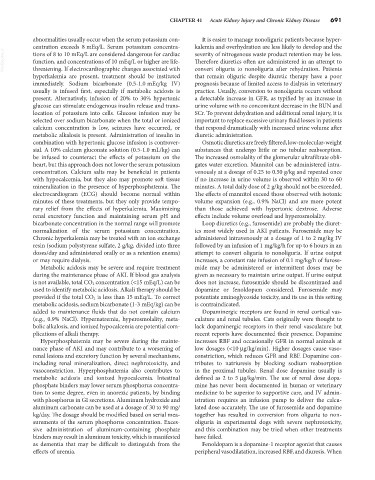Page 719 - Small Animal Internal Medicine, 6th Edition
P. 719
CHAPTER 41 Acute Kidney Injury and Chronic Kidney Disease 691
abnormalities usually occur when the serum potassium con- It is easier to manage nonoliguric patients because hyper-
centration exceeds 8 mEq/L. Serum potassium concentra- kalemia and overhydration are less likely to develop and the
VetBooks.ir tions of 8 to 10 mEq/L are considered dangerous for cardiac severity of nitrogenous waste product retention may be less.
Therefore diuretics often are administered in an attempt to
function, and concentrations of 10 mEq/L or higher are life-
threatening. If electrocardiographic changes associated with
that remain oliguric despite diuretic therapy have a poor
hyperkalemia are present, treatment should be instituted convert oliguria to nonoliguria after rehydration. Patients
immediately. Sodium bicarbonate (0.5-1.0 mEq/kg IV) prognosis because of limited access to dialysis in veterinary
usually is infused first, especially if metabolic acidosis is practice. Usually, conversion to nonoliguria occurs without
present. Alternatively, infusion of 20% to 30% hypertonic a detectable increase in GFR, as typified by an increase in
glucose can stimulate endogenous insulin release and trans- urine volume with no concomitant decrease in the BUN and
location of potassium into cells. Glucose infusion may be SCr. To prevent dehydration and additional renal injury, it is
selected over sodium bicarbonate when the total or ionized important to replace excessive urinary fluid losses in patients
calcium concentration is low, seizures have occurred, or that respond dramatically with increased urine volume after
metabolic alkalosis is present. Administration of insulin in diuretic administration.
combination with hypertonic glucose infusion is controver- Osmotic diuretics are freely filtered, low-molecular-weight
sial. A 10% calcium gluconate solution (0.5-1.0 mL/kg) can substances that undergo little or no tubular reabsorption.
be infused to counteract the effects of potassium on the The increased osmolality of the glomerular ultrafiltrate obli-
heart, but this approach does not lower the serum potassium gates water excretion. Mannitol can be administered intra-
concentration. Calcium salts may be beneficial in patients venously at a dosage of 0.25 to 0.50 g/kg and repeated once
with hypocalcemia, but they also may promote soft tissue if no increase in urine volume is observed within 30 to 60
mineralization in the presence of hyperphosphatemia. The minutes. A total daily dose of 2 g/kg should not be exceeded.
electrocardiogram (ECG) should become normal within The effects of mannitol exceed those observed with isotonic
minutes of these treatments, but they only provide tempo- volume expansion (e.g., 0.9% NaCl) and are more potent
rary relief from the effects of hyperkalemia. Maximizing than those achieved with hypertonic dextrose. Adverse
renal excretory function and maintaining serum pH and effects include volume overload and hyperosmolality.
bicarbonate concentration in the normal range will promote Loop diuretics (e.g., furosemide) are probably the diuret-
normalization of the serum potassium concentration. ics most widely used in AKI patients. Furosemide may be
Chronic hyperkalemia may be treated with an ion exchange administered intravenously at a dosage of 1 to 2 mg/kg IV
resin (sodium polystyrene sulfate, 2 g/kg, divided into three followed by an infusion of 1 mg/kg/h for up to 6 hours in an
doses/day and administered orally or as a retention enema) attempt to convert oliguria to nonoliguria. If urine output
or may require dialysis. increases, a constant rate infusion of 0.1 mg/kg/h of furose-
Metabolic acidosis may be severe and require treatment mide may be administered or intermittent doses may be
during the maintenance phase of AKI. If blood gas analysis given as necessary to maintain urine output. If urine output
is not available, total CO 2 concentration (<15 mEq/L) can be does not increase, furosemide should be discontinued and
used to identify metabolic acidosis. Alkali therapy should be dopamine or fenoldopam considered. Furosemide may
provided if the total CO 2 is less than 15 mEq/L. To correct potentiate aminoglycoside toxicity, and its use in this setting
metabolic acidosis, sodium bicarbonate (1-3 mEq/kg) can be is contraindicated.
added to maintenance fluids that do not contain calcium Dopaminergic receptors are found in renal cortical vas-
(e.g., 0.9% NaCl). Hypernatremia, hyperosmolality, meta- culature and renal tubules. Cats originally were thought to
bolic alkalosis, and ionized hypocalcemia are potential com- lack dopaminergic receptors in their renal vasculature but
plications of alkali therapy. recent reports have documented their presence. Dopamine
Hyperphosphatemia may be severe during the mainte- increases RBF and occasionally GFR in normal animals at
nance phase of AKI and may contribute to a worsening of low dosages (<10 µg/kg/min). Higher dosages cause vaso-
renal lesions and excretory function by several mechanisms, constriction, which reduces GFR and RBF. Dopamine con-
including renal mineralization, direct nephrotoxicity, and tributes to natriuresis by blocking sodium reabsorption
vasoconstriction. Hyperphosphatemia also contributes to in the proximal tubules. Renal dose dopamine usually is
metabolic acidosis and ionized hypocalcemia. Intestinal defined as 2 to 5 µg/kg/min. The use of renal dose dopa-
phosphate binders may lower serum phosphorus concentra- mine has never been documented in human or veterinary
tion to some degree, even in anorexic patients, by binding medicine to be superior to supportive care, and IV admin-
with phosphorus in GI secretions. Aluminum hydroxide and istration requires an infusion pump to deliver the calcu-
aluminum carbonate can be used at a dosage of 30 to 90 mg/ lated dose accurately. The use of furosemide and dopamine
kg/day. The dosage should be modified based on serial mea- together has resulted in conversion from oliguria to non-
surements of the serum phosphorus concentration. Exces- oliguria in experimental dogs with severe nephrotoxicity,
sive administration of aluminum-containing phosphate and this combination may be tried when other treatments
binders may result in aluminum toxicity, which is manifested have failed.
as dementia that may be difficult to distinguish from the Fenoldopam is a dopamine-1 receptor agonist that causes
effects of uremia. peripheral vasodilatation, increased RBF, and diuresis. When

